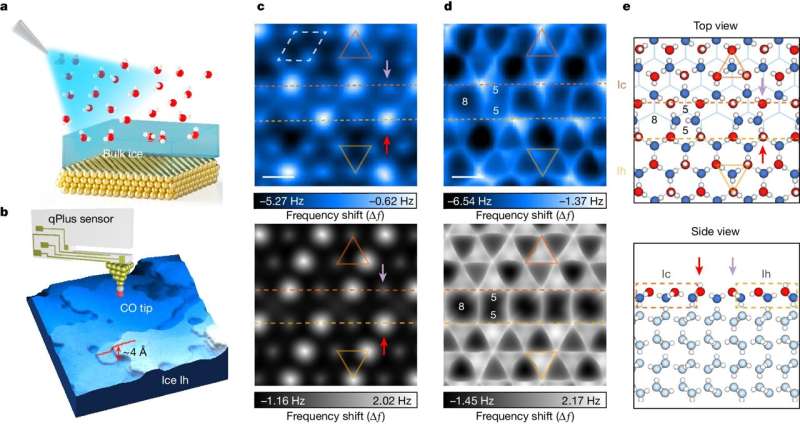May 23, 2024 report
This article has been reviewed according to Science X's editorial process and policies. Editors have highlighted the following attributes while ensuring the content's credibility:
fact-checked
peer-reviewed publication
trusted source
proofread
Atomic-resolution imaging shows why ice is so slippery

A team of physicists affiliated with several institutions in China has uncovered the reason behind the slipperiness of ice. In their study, published in the journal Nature, the group used atomic force microscopy to get a closer look at the surface of ice at different temperatures.
Prior research and a lot of anecdotal evidence have shown that ice is slippery, even when temperatures are well below the freezing point. Research has suggested this is because of a pre-melt coating that develops at the surface, which serves as a lubricant.
In this new study, the research team used an atomic force microscope fitted with a carbon monoxide atom on its tip to get a better look at the structure of normal ice and its pre-melt coating.
The researchers began by chilling ice inside the microscope chamber to -150°C and then using the microscope to look at its atomic structure. They could see that the internal ice (known as ice Ih), and the ice at the surface were different.
The ice Ih, as expected, was arranged in stacked hexagons. The ice on the surface, by contrast, was only partially hexagonal. The researchers also found defects in the ice at the border between the two types of ice that occurred as the different ice shapes met one another.
The researchers then raised the temperature in the chamber slightly, which resulted in more disorder as the differences in shape became more pronounced. The team then created a simulation showing how such disorder would impact the surface as a whole unit—it showed the disorder expanding all the way across the surface, giving the ice a liquid-like appearance that would be slippery if trod upon.
The research team explains that the reason their experiments were done at such low temperatures was that the microscope had to be operated in a vacuum; warmer temperatures would have led to sublimation, making it difficult to study the ice at the atomic level.
They also note that they plan to continue their study by using short laser bursts to heat the ice for very short amounts of time, allowing them to see what happens under warmer conditions.
More information: Jiani Hong et al, Imaging surface structure and premelting of ice Ih with atomic resolution, Nature (2024). DOI: 10.1038/s41586-024-07427-8
Journal information: Nature
© 2024 Science X Network




















